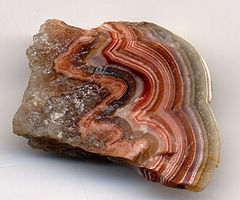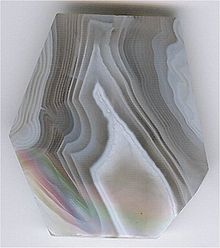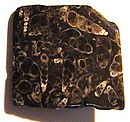- Agate
-
For other uses, see Agate (disambiguation).
Agate 
Banded agate (agate-like onyx); the specimen is 2.5 cm (1 inch) wideGeneral Category Quartz variety Chemical formula SiO2 silicon dioxide Identification Color White to grey, light blue, orange to red, black. banded Crystal habit Cryptocrystalline silica Crystal system Rhombohedral Microcrystalline Cleavage None Fracture Conchoidal with very sharp edges. Mohs scale hardness 6.5–7 Luster Waxy Streak White Diaphaneity Translucent Specific gravity 2.58–2.64 Refractive index 1.530–1.540 Birefringence up to +0.004 (B-G) Pleochroism Absent Agate (
 /ˈæɡət/) is a microcrystalline variety of silica, chiefly chalcedony, characterised by its fineness of grain and brightness of color. Although agates may be found in various kinds of rock, they are classically associated with volcanic rocks and can be common in certain metamorphic rocks.[1]
/ˈæɡət/) is a microcrystalline variety of silica, chiefly chalcedony, characterised by its fineness of grain and brightness of color. Although agates may be found in various kinds of rock, they are classically associated with volcanic rocks and can be common in certain metamorphic rocks.[1]Contents
Etymology and history
The stone was given its name by Theophrastus, a Greek philosopher and naturalist, who discovered the stone along the shore line of the river Achates (Greek: Ἀχάτης) sometime between the 4th and 3rd centuries BC.[2] Colorful agates and other chalcedonies were obtained over 3,000 years ago from the Achates River, now called Dirillo, in Sicily.[3]
Ancient use
Agate is one of the most common materials used in the art of hardstone carving, and has been recovered at a number of ancient sites, indicating its widespread use in the ancient world; for example, archaeological recovery at the Knossos site on Crete illustrates its role in Bronze Age Minoan culture.[4]
Formation and characteristics
Most agates occur as nodules in volcanic rocks or ancient lavas where they represent cavities originally produced by the disengagement of volatiles in the molten mass which were then filled, wholly or partially, by siliceous matter deposited in regular layers upon the walls. Such agates, when cut transversely, exhibit a succession of parallel lines, often of extreme tenuity, giving a banded appearance to the section. Such stones are known as banded agate, riband agate and striped agate.
In the formation of an ordinary agate, it is probable that waters containing silica in solution—derived, perhaps, from the decomposition of some of the silicates in the lava itself—percolated through the rock and deposited a siliceous coating on the interior of the vapour-vesicles. Variations in the character of the solution or in the conditions of deposition may cause a corresponding variation in the successive layers, so that bands of chalcedony often alternate with layers of crystalline quartz. Several vapour-vesicles may unite while the rock is still viscous, and thus form a large cavity which may become the home of an agate of exceptional size; thus a Brazilian geode lined with amethyst and weighing 35 tons was exhibited at the Düsseldorf Exhibition of 1902. Perhaps the most comprehensive review of agate chemistry is a recent text by Moxon cited below.
The first deposit on the wall of a cavity, forming the "skin" of the agate, is generally a dark greenish mineral substance, like celadonite, delessite or "green earth", which are rich in iron probably derived from the decomposition of the augite in the enclosing volcanic rock. This green silicate may give rise by alteration to a brown iron oxide (limonite), producing a rusty appearance on the outside of the agate-nodule. The outer surface of an agate, freed from its matrix, is often pitted and rough, apparently in consequence of the removal of the original coating. The first layer spread over the wall of the cavity has been called the "priming", and upon this base zeolitic minerals may be deposited.
Many agates are hollow, since deposition has not proceeded far enough to fill the cavity, and in such cases the last deposit commonly consists of quartz, often amethyst, having the apices of the crystals directed towards the free space so as to form a crystal-lined cavity, or geode.
On the disintegration of the matrix in which the agates are embedded, they are set free. The agates are extremely resistant to weathering and remain as nodules in the soil or are deposited as gravel in streams and shorelines.
Types of agate
A Mexican agate, showing only a single eye, has received the name of cyclops agate. Included matter of a green, golden, red, black or other color or combinations embedded in the chalcedony and disposed in filaments and other forms suggestive of vegetable growth, gives rise to dendritic or moss agate. Dendritic agates have fern like patterns in them formed due to the presence of manganese and iron oxides. Other types of included matter deposited during agate-building include sagenitic growths (radial mineral crystals) and chunks of entrapped detritus (such as sand, ash, or mud). Occasionally agate fills a void left by decomposed vegetative material such as a tree limb or root and is called limb cast agate due to its appearance.
Turritella agate is formed from silicified fossil Elimia tenera (erroneously considered Turritella) shells. E. tenera are spiral marine gastropods having elongated, spiral shells composed of many whorls. Similarly, coral, petrified wood and other organic remains or porous rocks can also become agatized. Agatized coral is often referred to as Petoskey stone or agate.
Greek agate is a name given to pale white to tan colored agate found in Sicily back to 400 B.C. The Greeks used it for making jewelry and beads. Even though the stone had been around centuries and was known to both the Sumerians and the Egyptians, both who used the gem for decoration and for playing important parts in their religious ceremonies, any agate of this color from Sicily, once an ancient Greek colony, is called Greek agate.
Another type of agate is Brazilian agate, which is found as sizable geodes of layered nodules. These occur in brownish tones interlayered with white and gray. Quartz forms within these nodules, creating a striking specimen when cut opposite the layered growth axis. It is often dyed in various colors for ornamental purposes.
Certain stones, when examined in thin sections by transmitted light, show a diffraction spectrum due to the extreme delicacy of the successive bands, whence they are termed rainbow agates. Often agate coexists with layers or masses of opal, jasper or crystalline quartz due to ambient variations during the formation process.
Other forms of agate include Lake Superior agate, carnelian agate (usually exhibiting reddish hues), Botswana agate, Ellensburg blue agate, blue lace agate, plume agates, tube agate (with visible flow channels), fortification agate (which exhibit little or no layered structure), fire agate (which seems to glow internally like an opal) and Mexican crazy-lace agate (which exhibits an often brightly colored, complex banded pattern) also called Rodeo Agate and Rosetta Stone depending on who owned the mine at the time.
Uses in industry and art
Industry uses agates chiefly to make ornaments such as pins, brooches, paper knives, inkstands, marbles and seals. Because of its hardness and ability to resist acids, agate is used to make mortars and pestles to crush and mix chemicals. Because of the high polish possible with agate it has been used for centuries for leather burnishing tools. Idar-Oberstein was one of the centers which made use of agate on an industrial scale. Where in the beginning locally found agates were used to make all types of objects for the European market, this became a globalized business around the turn of the 20th century: Idar-Oberstein imported large quantities of agate from Brazil, as ship's ballast. Making use of a variety of proprietary chemical processes, they produced colored beads that were sold around the globe.[5] Agates have long been used in arts and crafts. The sanctuary of a Presbyterian church in Yachats, Oregon, has six windows with panes made of agates collected from the local beaches.[6]
See also
Notes
- ^ Donald W. Hyndman, David D. Alt (2002). Roadside Geology of Oregon (18th ed.). Missoula, Montana: Mountain Press Publishing Company. pp. 286. ISBN 0-87842-063-0.
- ^ Achates, Henry George Liddell, Robert Scott, A Greek-English Lexicon, at Perseus
- ^ "Agate Creek Agate". http://www.gem.org.au/agate.htm. Retrieved 2007-07-01.
- ^ C. Michael Hogan. 2007. Knossos fieldnotes, Modern Antiquarian
- ^ Background Article on Idar Oberstein
- ^ http://www.yachatspresbyterian.org/webapp/GetPage?pid=211
References
- The Nomenclature of Silica by Gilbert Hart, American Mineralogist, Volume 12, pages 383-395, 1927
- International Colored Gemstone Association
- Mindat data
- Schumann, Walter. Gemstones of the World. 3rd edition. New York: Sterling, 2006.
- Moxon, Terry. "Agate. Microstructure and Possible Origin". Doncaster, S. Yorks, UK, Terra Publications, 1996.
- Pabian, Roger, et al. "Agates. Treasures of the Earth". Buffalo, New York, Firefly Books, 2006.
- Cross, Brad L. and Zeitner, June Culp. "Geodes. Nature's Treasures". Bardwin Park, California, Gem Guides Book Co. 2005.
External links
Jewellery Forms Anklet · Belt buckle · Belly chain · Bindi · Bracelet · Brooch · Chatelaine · Collar pin · Crown · Cufflink · Earring · Lapel pin · Necklace · Pendant · Ring · Tiara · Tie clip · Toe ring · Watch (pocket)Making PeopleProcessesCasting (centrifugal, lost-wax, vacuum) · Enameling · Engraving · Filigree · Metal clay · Plating · Polishing · Repoussé and chasing · Soldering · Stonesetting · Wire wrappingToolsMaterials Precious metal alloysBritannia silver · Colored gold · Crown gold · Electrum · Platinum sterling · Shakudo · Shibuichi · Sterling silver · TumbagaMineral gemstonesAventurine · Agate · Alexandrite · Amethyst · Aquamarine · Carnelian · Citrine · Diamond · Diopside · Emerald · Garnet · Jade · Jasper · Lapis lazuli · Larimar · Malachite · Marcasite · Moonstone · Obsidian · Onyx · Opal · Peridot · Quartz · Ruby · Sapphire · Sodalite · Sunstone · Tanzanite · Tiger's eye · Topaz · Tourmaline · TurquoiseOrganic gemstonesTerms Crystalline - Coesite
- Cristobalite
- Moganite
- Quartz
- Seifertite
- Stishovite
- Tridymite
Cryptocrystalline Amorphous Miscellaneous Notable varieties - Amethyst
- Ametrine
- Citrine
- Milky quartz
- Rose quartz
- Smoky quartz
- Shocked quartz
Categories:- Minerals
- Quartz varieties
- Greek loanwords
Wikimedia Foundation. 2010.



